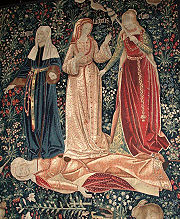
Parcae
Encyclopedia

Roman mythology
Roman mythology is the body of traditional stories pertaining to ancient Rome's legendary origins and religious system, as represented in the literature and visual arts of the Romans...
, the Parcae were the personifications of destiny
Destiny
Destiny or fate refers to a predetermined course of events. It may be conceived as a predetermined future, whether in general or of an individual...
, often called The Fates in English. Their Greek equivalent
Interpretatio graeca
Interpretatio graeca is a Latin term for the common tendency of ancient Greek writers to equate foreign divinities to members of their own pantheon. Herodotus, for example, refers to the ancient Egyptian gods Amon, Osiris and Ptah as "Zeus", "Dionysus" and "Hephaestus", respectively.-Roman...
were the Moirae
Moirae
The Moirae, Moerae or Moirai , in Greek mythology, were the white-robed incarnations of destiny . Their number became fixed at three...
. They controlled the metaphorical thread of life of every mortal and immortal from birth to death. Even the gods feared the Parcae. Jupiter
Jupiter (mythology)
In ancient Roman religion and myth, Jupiter or Jove is the king of the gods, and the god of the sky and thunder. He is the equivalent of Zeus in the Greek pantheon....
also was subject to their power.
The names of the three Parcae were:
- Nona (Greek equivalent ClothoClothoClotho is one of the Three Fates or Moirae, in ancient Greek mythology. Her Roman equivalent is Nona. Clotho was responsible for spinning the thread of human life. She also made major decisions, such as when a person was born, thus in effect controlling people's lives...
), who spun the thread of life from her distaffDistaffAs a noun, a distaff is a tool used in spinning. It is designed to hold the unspun fibers, keeping them untangled and thus easing the spinning process. It is most commonly used to hold flax, and sometimes wool, but can be used for any type of fiber. Fiber is wrapped around the distaff, and tied in...
onto her spindleSpindle (textiles)A spindle is a wooden spike used for spinning wool, flax, hemp, cotton, and other fibres into thread. It is commonly weighted at either the bottom middle or top, most commonly by a circular or spherical object called a whorl, and may also have a hook, groove or notch, though spindles without...
; - DecimaDecima (mythology)In Roman mythology, Decima was one of the Parcae, or the Fates. She measured the thread of life with her rod. She was also revered as the goddess of childbirth. Her Greek equivalent was Lachesis....
(Greek LachesisLachesis (mythology)In Greek mythology, Lachesis was the second of the Three Fates, or Moirae, also known as the Triple Moon Goddesses or the Lunar Dieties. Each phase of the moon representing each of the fates - Clotho, Lachesis and Atropos...
), who measured the thread of life with her rod; - Morta (Greek AtroposAtroposAtropos or Aisa , in Greek mythology, was one of the three Moirae, goddesses of fate and destiny. Her Roman equivalent was Morta.Atropos or Aisa was the oldest of the Three Fates, and was known as the "inflexible" or "inevitable." It was Atropos who chose the mechanism of death and ended the life...
), who cut the thread of life and chose the manner of a person's death.
The earliest extant document of these deities are three small stelae (cippi) found near the location of ancient Lavinium
Lavinium
Lavinium was a port city of Latium, to the south of Rome, at a median distance between the Tiber river at Ostia and Anzio. The coastline then, as now, was a long strip of beach. Lavinium was on a hill at the southernmost edge of the Silva Laurentina, a dense laurel forest, and the northernmost...
shortly after the end of World War II
World War II
World War II, or the Second World War , was a global conflict lasting from 1939 to 1945, involving most of the world's nations—including all of the great powers—eventually forming two opposing military alliances: the Allies and the Axis...
. They bear the inscription:
Neuna fata, Neuna dono, Parca Maurtia dono
The names of two of the three Roman Parcae are recorded (Neuna = Nona, Maurtia = Morta) and connected to the concept of fata.
Nona was supposed to determine the lifespan of man as the dies lustricus, that is, the day on which the name of the child was chosen, which occurred on the ninth day from birth for a male and the eighth for a female.
The recurrence of the nundinae was also considered a dies festus and as such nefas by some Roman scholars as Julius Caesar and Cornelius Labeo
Cornelius Labeo
Cornelius Labeo was an ancient Roman theologian and antiquarian who wrote on such topics as the Roman calendar and the teachings of Etruscan religion . His works survive only in fragments and testimonia. He has been dated "plausibly but not provably" to the 3rd century AD...
, because on it the flaminica dialis offered the sacrifice of a goat to Jupiter in the Regia
Regia
The Regia was a structure in Ancient Rome, located in the Roman Forum. It was originally the residence of the kings of Rome or at least their main headquarters, and later the office of the Pontifex Maximus, the high priest of Roman religion. It occupied a triangular patch of terrain between the...
.
One of the sources for the Parcae is Metamorphoses by Ovid
Ovid
Publius Ovidius Naso , known as Ovid in the English-speaking world, was a Roman poet who is best known as the author of the three major collections of erotic poetry: Heroides, Amores, and Ars Amatoria...
, II 654, V 532, VIII 452, XV 781.

